Source: W3C DAO
As we all know, Filecoin is a decentralized storage network that uses blockchain technology and cryptocurrency (FIL) to incentivize file storage and retrieval between users and miners trade. Filecoin's goal is to create an open, competitive, reliable, self-healing storage market to provide infrastructure for Web 3.0. Filecoin and IPFS protocols complement each other and jointly build a distributed Internet.

Recently, the data of Filecoin storage network has been advancing by leaps and bounds. Prices have also gone up.
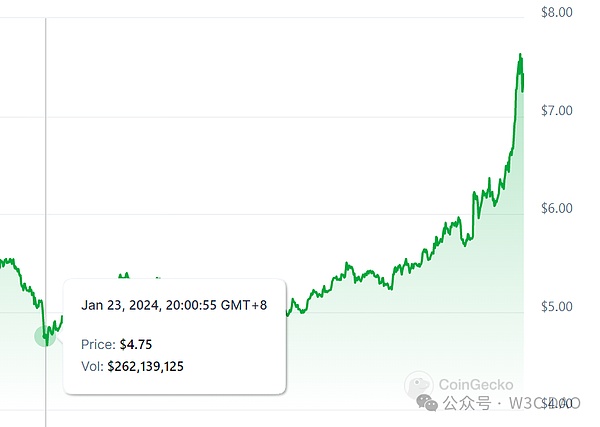
Filecoin is still in this bull market Any chance? Is there still hope for the 1000U goal? Let us read Messari's latest research report with this question.
Messari’s latest report shows:
Filecoin’s storage market continued to grow in the fourth quarter of 23, with active transaction volume A month-on-month increase of 23% and a year-on-year increase of 414%. Meanwhile, storage utilization increased from 13% in Q3'23 to 18% in Q4'23, as Filecoin's storage capacity continued to decline by 15% sequentially.
As of the end of 2023, more than 1,800 customers have loaded datasets on Filecoin, 465 of which exceed 1,000 TiB in size, a10% month-on-month increase and a 196% year-on-year increase.
The Filecoin Virtual Machine (FVM) brings Ethereum-style smart contracts to enable new use cases. Since the launch of FVM in March 2023, TVL has exceeded $230 million by the end of 2023.
The proposal to deploy Uniswap V3 on FVM has been successfully implemented and will likely usher in a new stage of DeFi applications built on the Filecoin network.
The FIP0001v2 community program was launched to improve and expand the Filecoin Improvement Process (FIP) and governance processes.
Key indicators
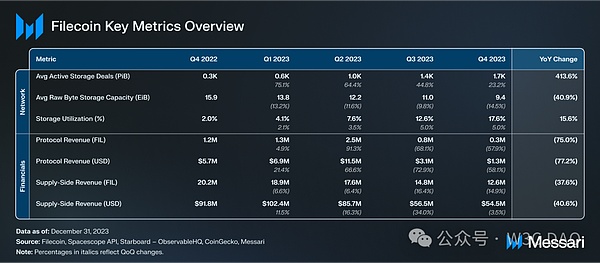
Performance Analysis
Filecoin blockchain is used to store data in a decentralized manner between two parties:
The demand side, that is, the storage user who needs data storage
The supply side is the storage provider with excess network capacity.
Transaction
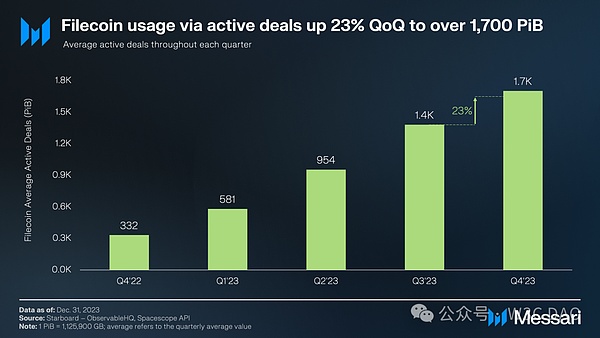
In Q4’23, Filecoin continued its adoption of decentralized storage through active transaction growth. Nearly 1,700 PiB are stored on the Filecoin network through active transactions in Q4 2023, a23% sequential increase from the 1,400 PiB in Q3 2023 and more than 4x year-over-year growth from the 332 PiB in Q4 22 .
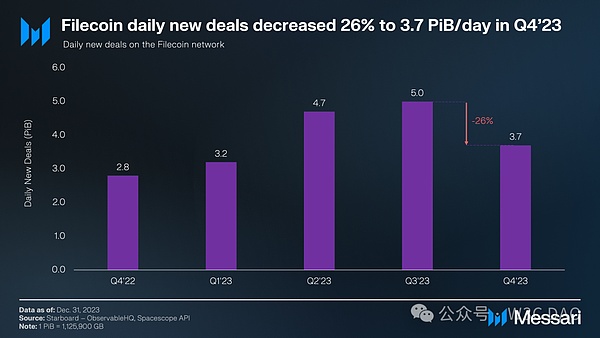
At the same time , daily new transaction volume fell 26% quarter-on-quarter after growing for the past four consecutive quarters. While still positive, the slowdown in new transaction growth corresponds to an overall reduction in storage provider incentives (as discussed later in the supply-side revenue section). Furthermore, the increase in new transactions corresponds to an increase in Filecoin network utilization.
Utilization and capacity
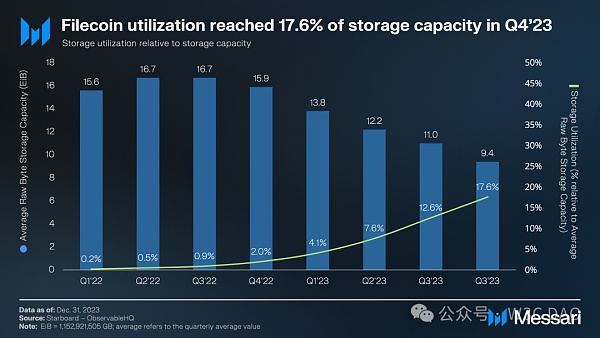
< p powered-by="xiumi.us">Filecoin's storage utilization relative to total available storage capacity increased from 12.6% in Q3'23 to 17.6% in Q4'23. While this growth is a positive sign for Filecoin adoption through active storage transactions, it requires the context of network capacity.
In Q4’23, Filecoin’s average raw byte storage capacity fell 15% QoQ to 9.4 EiB. This gradual decline began about a year ago, when average raw byte storage capacity reached an all-time high of nearly 17 EiB in Q3'22.
The decline in average raw byte storage capacity is further reflected in the decline in the total number of storage providers, which followed an all-time high of over 4,100 in Q3'22 to Q3'23. The number continued to decline to 3,390 at the end of the fourth quarter.
Customers
Following Messari’s guidelines for decentralized storage networks, Filecoin aims to provide cold storage solutions (such as archiving and recovery) to enterprises and developers. Its competitive pricing and ease of access help attract Web2 customers looking for cost-effective alternatives for storing large amounts of archival data. Active efforts outside of cold storage are driven by: Banyan, Lighthouse, RIBS, Retriev, Seal and Flamenco.
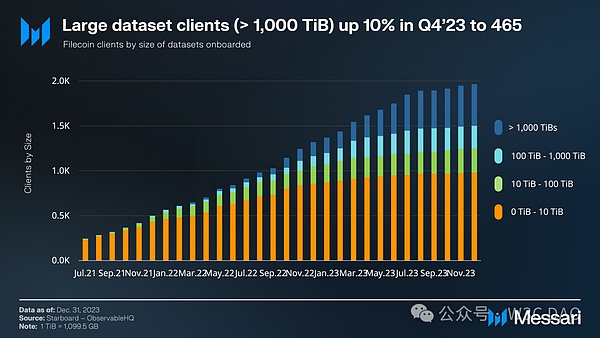
As of the 23rd At the end of Q4, a total of 1,808 customers had installed datasets on Filecoin. Of these customers, 465 are onboarding large data sets (e.g., those storing more than 1,000 TiB in size), a 10% increase from 421 customers in Q3 2023.
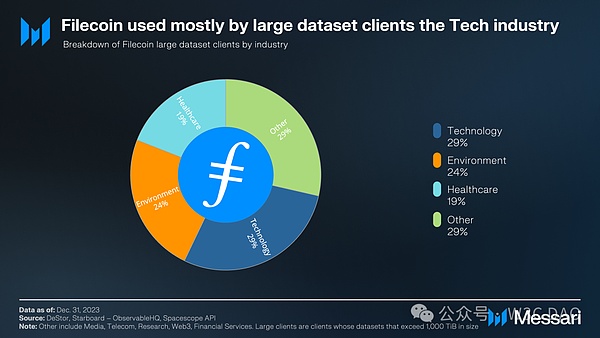
Proactive for customers with large data sets An industry breakdown by storage shows that the industries utilizing Filecoin the most are technology (35%) and natural resources (31%). To encourage usage through active transactions, we offer a variety of storage services, including: NFT.Storage, Web3.Storage, Seal, Banyan, and Steeldome.
According to Filecoin’s client browsers, its primary customers range from New York City and the University of Southern California Shoah Foundation to Web3 platform OpenSea and Layer-1 network Solana. Other noteworthy efforts leveraging the Filecoin network include:
The Victor Chang Heart Institute protects and shares research data.
The Library of Democracy stores the datasets collected by the Internet Archive at the end of its administration.
The SETI Institute uses Filecoin to store astronomical research data.
UC Berkeley partners with Seal Storage to store physics research results.
GenRAIT leverages Estuary to store critical genomic data on Filecoin.
The research center Starling Laboratory stores sensitive digital records of human history.
Ewesion (China’s fastest growing graphics file host) uses Filecoin for data saving.
DeSci Labs uses decentralized data storage on Filecoin to enable research results to be replicated and independently verified by other researchers.
An overview of featured clients utilizing the Filecoin network can be accessed here.
FVM uses
Filecoin Virtual Machine (FVM) brings Ethereum-style smart contracts to Filecoin. Since launch in March 2023, TVL has exceeded $230 million by the end of 2023. DeFi applications provide storage providers with greater access to FIL, potentially making data loading more efficient. As of December 31, 2023, there were over 2,700 unique contracts deployed on FVM and used by over 22,000 monthly active users. Together, these users generated more than 1.8 million transactions.
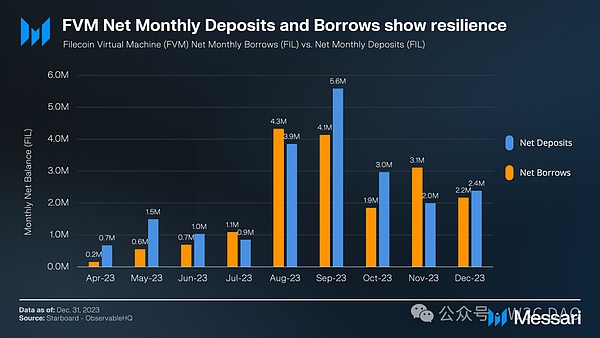
Deploying Uniswap V3 on FVM The proposal was adopted in October and successfully implemented. The deployment of Uniswap contracts on FVM may usher in a new stage of DeFi applications built on the Filecoin network. As Filecoin continues to acquire new users and valuable data sets, it can serve as the basis for developing monetizable FVM-enabled use cases around the data.
Ecosystem Overview
The Filecoin ecosystem has been actively developing a builder funnel. It regularly participates in hackathons and accelerators to help early-stage projects and teams secure funding from Protocol Labs or affiliated entities. The ecosystem is designed to support various use cases in different areas: namely data infrastructure, media streaming, metaverse and gaming. As of December 2023, more than 100 known projects have been developed within the Filecoin ecosystem, including key projects-Glif and Titan Network.
Glif
On February 6, Filecoin ecological liquidity leasing agreement Glif announced the completion of a US$4.5 million seed round of financing. This round of financing was led by Multicoin Capital, Zee Prime Capital, Fintech Collective, Big Brain Holdings, Protocol Labs and other investors participated.
In short, Glif provides FIL token holders and others with a way to earn income through its "liquidity leasing" model. According to Filfox data, Glif is currently the largest protocol in the Filecoin ecosystem, with a TVL of over US$139 million.
The Glif protocol enables Filecoin token holders, storage providers (SPs) or miners to earn rewards for depositing tokens into its protocol. Mechanically, Glif is like a liquidity staking platform, but since Filecoin is not a proof-of-stake (PoS) network, it is called a liquidity leasing protocol.
Prior to launching the Glif protocol, Glif team leaders Jon Schwartz and Peter Andersen have been building basic products in the Filecoin ecosystem since 2019.
Titan Network
Titan Network is a software and service developer that aims to create a trustless, distributed network around the production and delivery of computing power using shared proofs. Smart contract network.
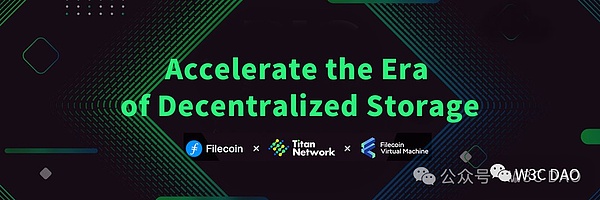
Titan by San It consists of three parts: software, trading market and protocol. The software product is for the management of computing power, the trading market is used for the distribution of computing power, and the protocol part provides a global computing power integration and distribution platform.
Titan also officially cooperated with Filecoin and launched Titan Ultra Network.
Titan Ultra Network is based on Filecoin (decentralized storage project) and IPFS (InterPlanetary File System, interplanetary file system), providing resources for decentralized shared CDN acceleration services for Web3.0 The platform uses edge technology to make full use of the bandwidth, storage, computing and other resources of lightweight idle devices in thousands of households to build a large-scale edge cloud computing network.
Anyone can become an edge node of Titan Ultra Network and participate in the construction of a "shared computing" cycle model that converts idle household resources into valuable shared services and reuses idle resources.
It is reported that Titan Network has previously received US$1 million in support from the Filecoin official foundation.
Written at the end
Data storage on Filecoin experienced significant growth in Q4’23, with active storage Transaction volume increased by 23% month-on-month and 414% year-on-year. Storage utilization increased from 13% in Q3'23 to 18% in Q4'23 as Filecoin's storage capacity continued to decline by 15% sequentially.
As of the end of 2023, more than 1,800 customers have loaded data sets on Filecoin, of which 465 customers have data volumes exceeding 1,000 TiB, a month-on-month increase of 10% and a year-on-year increase of 196%. Storage fee revenue in FIL fell 58% in Q4'23 (down 58% in USD), consistent with the overall decline in demand-side revenue in the decentralized cloud storage space.
The proposal to deploy Uniswap V3 on FVM has been successfully implemented and may usher in a new stage of DeFi applications built on the Filecoin network. As Filecoin continues to gain new users and valuable data sets, it can serve as the basis for developing monetizable FVM-enabled use cases around the data.
Is Filecoin still far away from 1000U?
 JinseFinance
JinseFinance
 JinseFinance
JinseFinance JinseFinance
JinseFinance JinseFinance
JinseFinance JinseFinance
JinseFinance JinseFinance
JinseFinance JinseFinance
JinseFinance Bankless
Bankless Coindesk
Coindesk Bitcoinist
Bitcoinist Cointelegraph
Cointelegraph